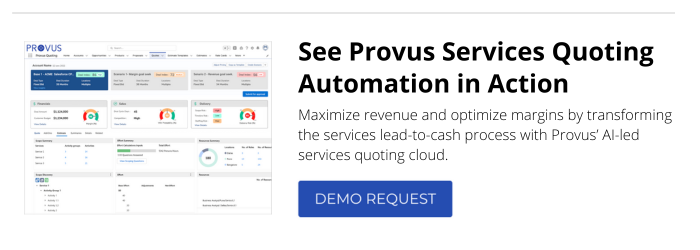Chris Souza, Head of Marketing for Provus, brings Professional Services Leaders tips from the trenches with Mahesh Baxi, Co-Founder and CEO of Provus, and Joe Longo, PSA Principal at Oracle NetSuite. Together, they helped write the book for professional services leadership.
During their conversation, Chris polls the audience of Professional Services Leaders for their biggest challenge today when selling professional services, and the results are conclusive. Most attendees agreed; deal structures are putting too much pressure on margins.
This problem raises several questions, each of which warrants separate webinars, so let’s cut to the bottom line.
Why do Professional Services Leaders struggle to forecast resource allocation and revenue during sales cycles?
Upon inspection, Joe and Mahesh noticed a distinct lack of transparency between databases in a services operations tech stack. Sales representatives must contend with data structures and quoting inputs outside their immediate access (CRM), creating friction from the very beginning of the process.
This friction travels upstream as a dozen approval requests for your project managers and VPs. Meanwhile, your prospect’s needs haven’t changed, and your representatives only have so much time to close the deal.
When sales representatives are equipped with opaque information in a spreadsheet, they sell deals that do not appropriately consider every aspect of implementation. So what happens “once the deal is done, once the rubber hits the road? The conversations that service teams end up having is [about not knowing what was or was not in the scope, when it should or shouldn’t have been, so just getting the job done] is a change order.” Not only is this a suboptimal customer experience, but customers can sense the tension in this lack of transparency, ultimately eroding their confidence in your ability to deliver results one nervous conversation at a time. Transparency builds trust between every party. After all, “customers don’t engage for the company’s reasons but for their own.” [1]
It may or may not be obvious, but look for these clues to spot friction in your own sales process:
- Sales representatives and VPs often disagree over the expected profit of any given deal.
- A history of excessive change orders during project launch.
- Hindsight reveals that you’ve lost money on too many projects.
- Everyone involved has too many spreadsheets.
How services professionals can optimize their lead-to-cash process and maximize revenue
Now that we know what the problem entails, we can solve it. Before implementing any solution, strategize how you will acquire and organize data from every department; otherwise, any system you implement will eventually become an expensive headache to retrofit.
Ask yourself these questions:
- What questions are and aren’t asked when scoping, estimating, and quoting?
- How do your realized margins compare to projections?
- What information must be accessible at all times between internal teams for approval?
- What risk factors can we preemptively mitigate?
Joe and Mahesh go on to prescribe strategies for obtaining those answers:
- Investigate your corporate model and align your whole team on the expected margin of a particular project so that each team shares knowledge.
- Thoroughly document your methodologies down to approvals.
- Perform case studies to understand how specific statements of work affect service delivery timelines, resource allocations, and margins.
Once you develop logical, flexible, clearly defined goals, rules, and conditions for every step in your sales-to-service process, then it’s time to consider your technology.
AI for Professional Services Leaders
As leaders, we have to keep our heads above water to spot incoming trends that may upend our existing processes. While change is often difficult for Professional Services Leaders, it is a necessary step to harnessing new technologies and preventing our organizations from falling behind the competition. AI is here, and while it still struggles to generate lifelike images of human hands, there’s no doubting AI’s ability to process and analyze data at scale.
Joe recounts the words of his friends at Google: “They believe that in the immediate future, within the next year or so, you need to have [your company’s AI tools] in your skillset just to get your job done.”
Provus Services Quoting’s enterprise data foundation is designed to acquire and organize data in ways that can break the departmental data silos that hinder profitable business and empower services teams with accurate, relevant, and timely information at their fingertips. Companies choosing to ignore new technology and stick with Excel-based “processes” will be outpaced by AI and organizations that structure their data in meaningful ways. Manually updating spreadsheets one department at a time will never keep up with automating tedious tasks, minimizing the risk of human error, and leveraging AI capabilities.
If your company was a late adopter of email, intranet, or cloud, don’t make the same mistake with AI. Begin preparing your data strategies now in a way that can adopt AI capabilities today, or you will be left behind tomorrow.
Reap the benefits of implementing Services CPQ with professional services automation
Everything comes back to the customer, and that is where you’ll find most of the outcomes of all this work. With AI guiding your sales process and automation handling the paperwork end-to-end, your lead-to-cash process is transparent internally and externally, which means your sales team can sell deals your delivery team can implement without renegotiating scope. Your customers will wholly agree with the SOW before the deal closes.
Because these are transparent systems, everyone at every stage of the process is privy to the ongoing activity behind your customer’s expected ROI. From the customer’s perspective, this makes it easy to continually engage with your processes, and stay excited for the outcome during delivery.
There’s one more benefit to evolving your sales process, and Joe says it best:
“As soon as you automate [interdepartmental communication processes] and remove excel, what we found is that all the [internal] arguments went away.”
Automating internal approvals gives your customers the impression that all your agents understand the relationship between your business and theirs because, with Provus, they do. When sales teams can see how resource allocations, timelines, and margins fluctuate while speaking with customers, they have what they need to negotiate accurately and effectively.
Provus customers have experienced:
- 70% reduction in quote cycle time
- 105% increase in average deal size
- 300% increase in ROI on your Provus investment
Results like these are simply impossible with rebuilt spreadsheets because those are neither scalable nor a system. Archaic tools have limited usability, so modern professional services teams need to build meaningful data structures if they wish to operate with unparalleled efficiency. Prepare to transition away from spreadsheets by thoroughly documenting your methodologies before booking software demos so you can avoid designing a system that creates more problems than it solves.
We’ll be here when you’re ready.
References:








